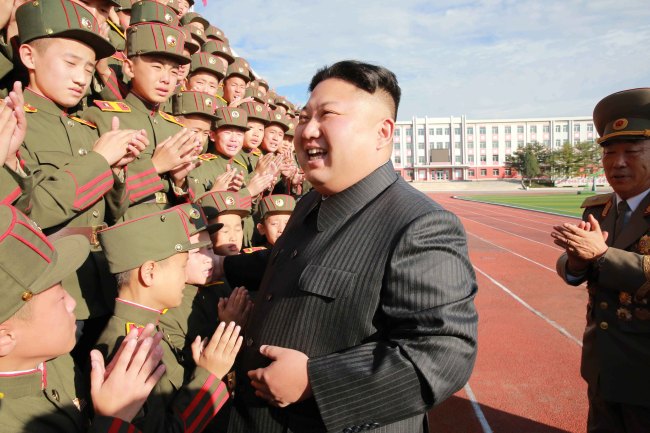NK renews threat to test hydrogen bomb over Pacific
Analysts remain pessimistic on test, saying it would bring “unsurmountable consequences”
By Yeo Jun-sukPublished : Oct. 26, 2017 - 16:54
North Korea has renewed a threat to conduct an atmospheric nuclear test over the Pacific Ocean, fueling speculation as to when the reclusive regime will break its longest hiatus in military provocations in recent months.
But experts here said Thursday such a test is unlikely to happen, citing complicated risks involved. Some suggested that the North’s military inaction since Sept. 15 missile launch may reflect its dilemma over whether or not to sustain the level of military tensions with the US.
On Wednesday, the North’s senior diplomat Ri Yong-pil told CNN that Foreign Minister Ri Yong-ho’s previous warning of detonating a hydrogen bomb over the Pacific should be “taken literally.”
“(North Korea) has always brought its words into action,” Lee told CNN in Pyongyang. “The foreign minister is very well aware of the intentions of our supreme leader (Kim Jong-un), so I think you should take his words literally.”
During his visit to New York for the United Nations General Assembly last month, Ri Yong-ho floated the idea of the atmospheric nuclear test. The threat came hours after US President Donald Trump’s UN speech, during which he threatened to “totally destroy” North Korea if national security were at risk.
If the North tests a nuke, it would break the longest hiatus of military provocations since South Korean President Moon Jae-in’s inauguration in May. The last provocation was a ballistic missile launch on Sept. 15.
But experts here say the threat is unlikely to materialize. It would entail “unsurmountable consequences” that the North cannot afford, they said.

One of key risks involved in launching a nuclear warhead toward the Pacific -- likely via ballistic missile -- is the possibility of a clash with civilian aircrafts or fishing vessels, as Pyongyang has yet to secure advanced technology to accurately deliver the missile to an intended target, said Cha Doo Hyeogn, a senior researcher at the Asan Institute for Policy Studies, a Seoul-based think tank.
“North Korea doesn’t have the territory to conduct nuclear tests in the Pacific and can’t issue a warning in advance for a test,” he said. “Delivering the missile to the Pacific means sending it to the water crowded with ships and airplanes.”
An atmospheric nuclear test has been banned since 1963 under the Limited Test Ban Treaty, signed by the three nuclear states -- US, former Soviet Union, United Kingdom -- and many non-nuclear states, along with underwater and outer space tests. China was the last country to conduct such a test, but it has not carried one out since 1980.
David Albright, founder and president of the Washington-based Institute for Science and International Security, told Voice of America that such a test would constitute a grave provocation against the international community and bring devastating fallout to North Korea.
In order to avoid the risk of clashing with airplanes or ships, North Korea may try to detonate a nuclear bomb underwater, using naval vessels, but that would face similar backlash and most likely be deterred by the US Navy’s operation in the Pacific.
“North Korea can think about using two ships to detonate a nuclear bomb, one carrying out the test and the other monitoring the result. But they would likely be caught and taken over by patrolling US warships,” said Shin Beom-chul, a security expert at the Korea National Diplomatic Academy in Seoul.
Given the potential fallout, the most likely course of action for Pyongyang is to wait until the regime perfects key technology for a workable intercontinental ballistic missile capable of hitting the US continent, Shin added.
Breaking from its pattern of celebrating major events with a military show of force, North Korea has avoided firing ICBMs or other ballistic missiles since Sept. 15 despite rampant speculation that Pyongyang would stage a major provocation when it celebrated the founding day of its ruling Korea Workers’ Party earlier this month.
Such moves reflect Pyongyang’s dilemma over whether to sustain the level of tension by staging more provocations, as the US has also continued to flex its military muscle by dispatching a nuclear-powered aircraft carrier and strategic bomber B-1B toward the North‘s territory, analysts said.
“I think North Korea is also struggling to figure out what exactly President Trump is getting at,” said Cha. “Take the flyover of B-1Bs as an example. It is something that North Korea has rarely seen from the US.”
By Yeo Jun-suk (jasonyeo@heraldcorp.com)



![[Herald Interview] 'Amid aging population, Korea to invite more young professionals from overseas'](http://res.heraldm.com/phpwas/restmb_idxmake.php?idx=644&simg=/content/image/2024/04/24/20240424050844_0.jpg&u=20240424200058)















![[Today’s K-pop] Kep1er to disband after 2 1/2 years: report](http://res.heraldm.com/phpwas/restmb_idxmake.php?idx=642&simg=/content/image/2024/04/25/20240425050792_0.jpg&u=)